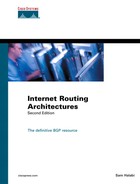Book Description
The industry's leading resource for Internet routing solutions and scenarios
Explore the functions, attributes, and applications of BGP-4, the de facto interdomain routing protocol, through practical scenarios and configuration examples
Learn the contemporary Internet structure and understand how to evaluate a service provider in dealing with routing and connectivity issues
Master the addressing techniques--including Classless Interdomain Routing (CIDR)--that are demanded today to facilitate the Internet's rapid and continuing growth
Develop optimal routing policies--redundancy, traffic balancing, symmetry, and stability--for your network
Learn how to seamlessly integrate your intradomain and interdomain routing and manage large and growing autonomous systems
Internet Routing Architectures, Second Edition, explores the ins and outs of interdomain routing network designs with emphasis on BGP-4 (Border Gateway Protocol Version 4)--the de facto interdomain routing protocol.
Using a practical, example-oriented approach, this comprehensive resource provides you with real solutions for ISP connectivity issues. You will learn how to integrate your network on the global Internet and discover how to build large-scale autonomous systems. You will also learn to control expansion of interior routing protocols using BGP-4, design sound and stable networks, configure the required policies using Cisco IOS Software, and explore routing practices and rules on the Internet.
157870233X020206
Table of Contents
- Copyright
- About the Authors
- About the Technical Reviewers
- Acknowledgments
- Introduction
- The Contemporary Internet
- Evolution of the Internet
- Origins and Recent History of the Internet
- Network Access Points
- Routing Arbiter Project
- The Very High-Speed Backbone Network Service
- Transitioning the Regional Networks from the NSFNET
- NSF Solicits NIS Managers
- Other Internet Registries
- Internet Routing Registries
- The Once and Future Internet
- Looking Ahead
- Frequently Asked Questions
- References
- ISP Services and Characteristics
- IP Addressing and Allocation Techniques
- Evolution of the Internet
- Routing Protocol Basics
- Effective Internet Routing Designs
- Internet Routing Device Configuration
- Appendixes
- Index
